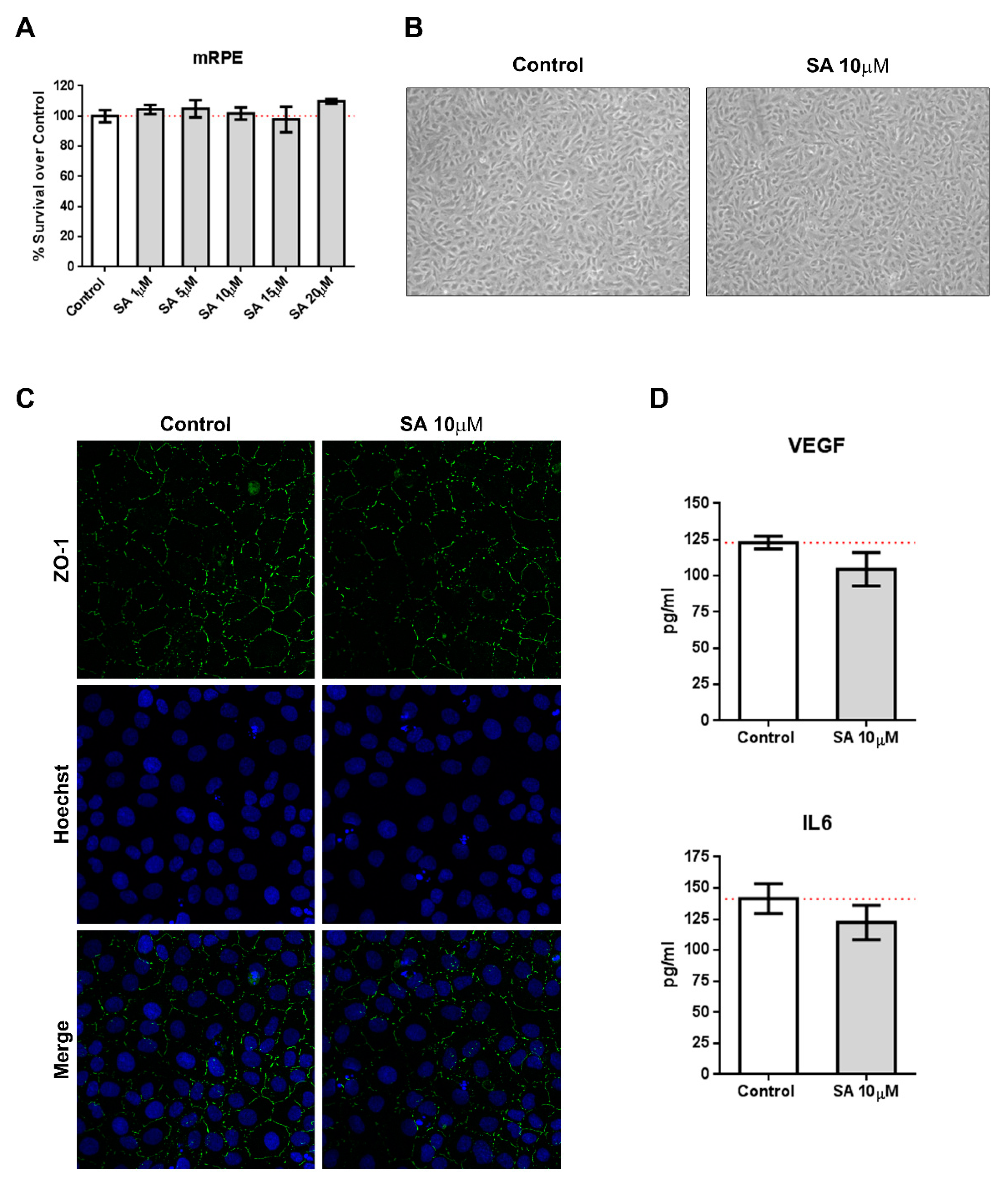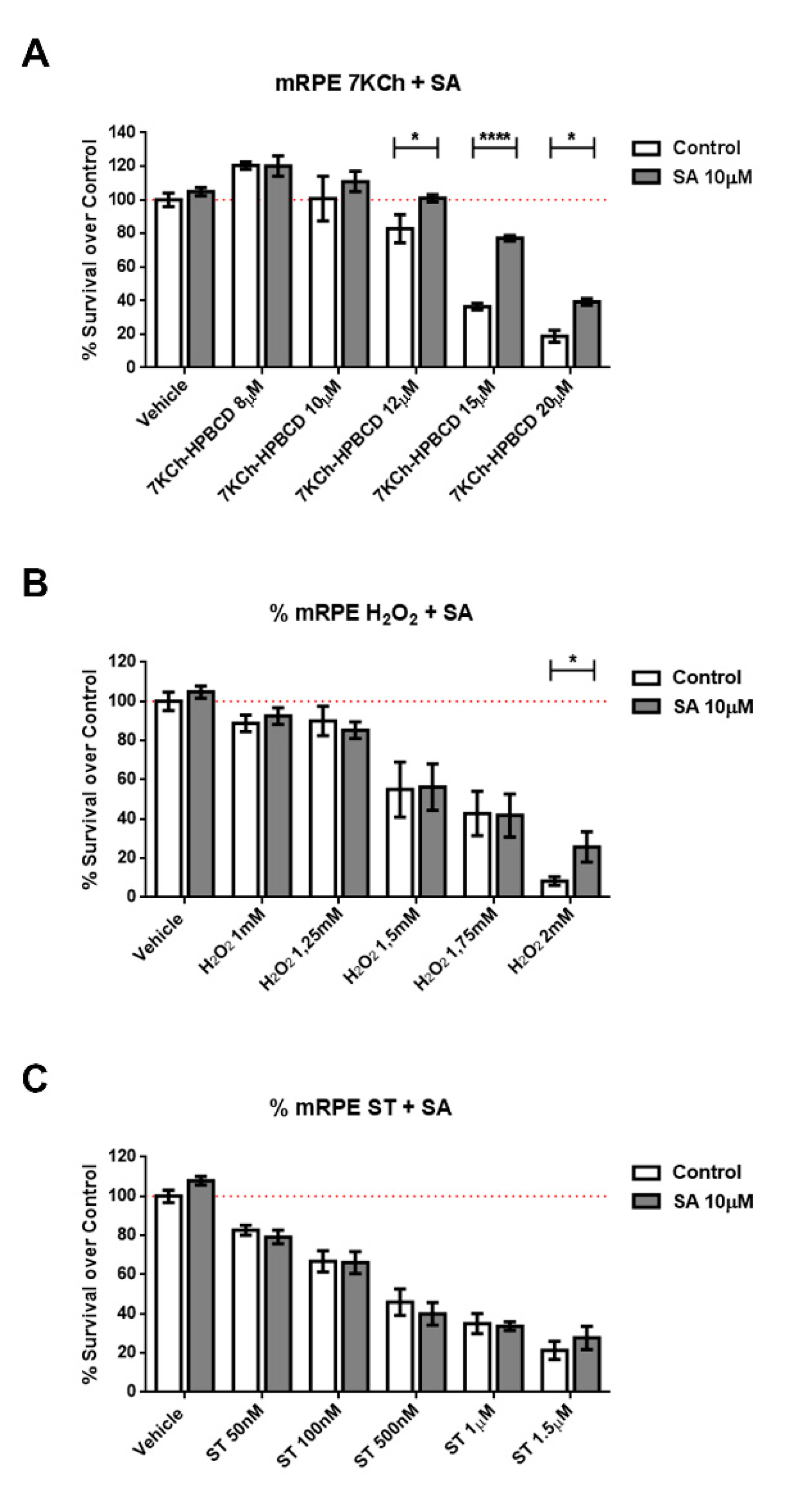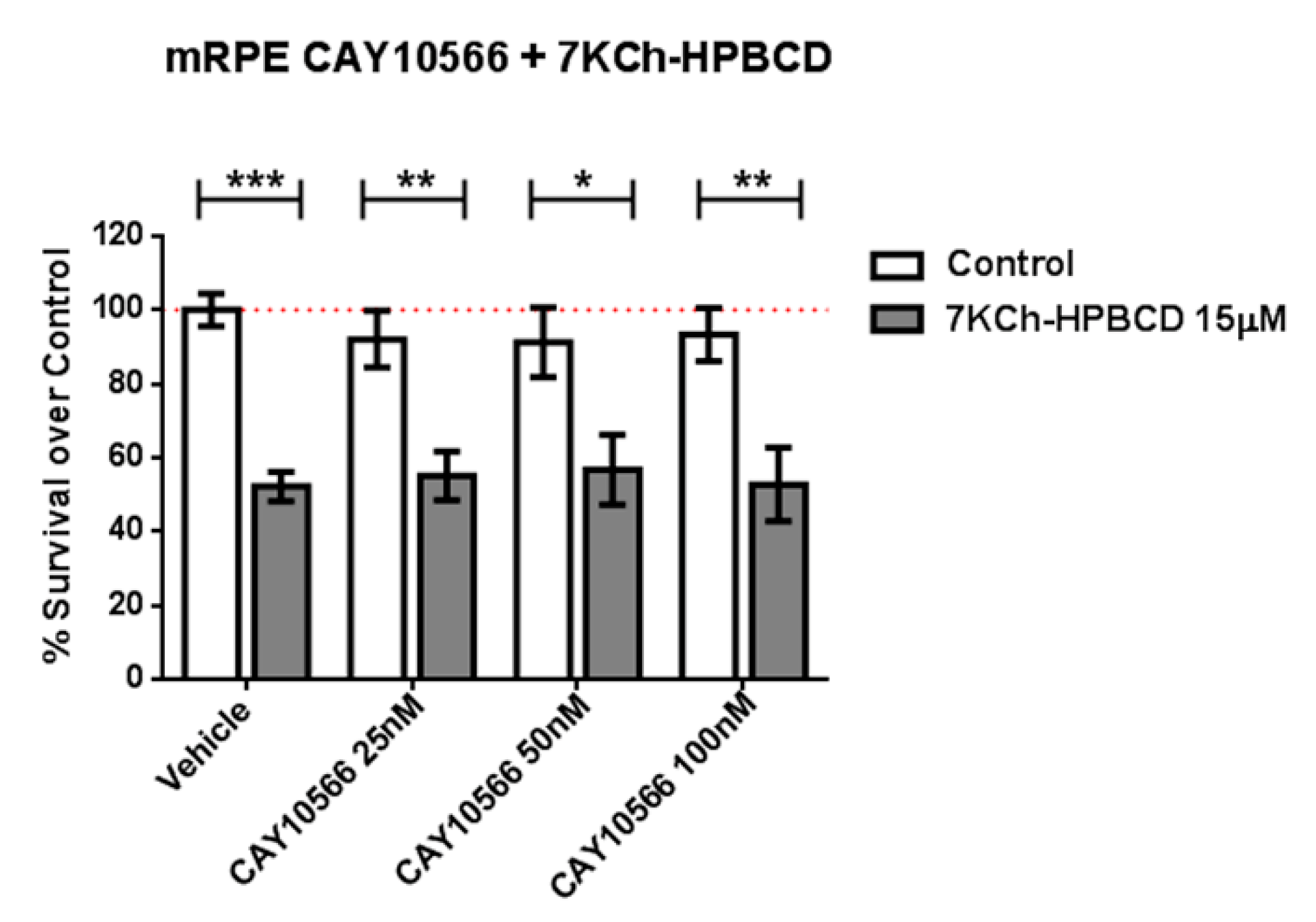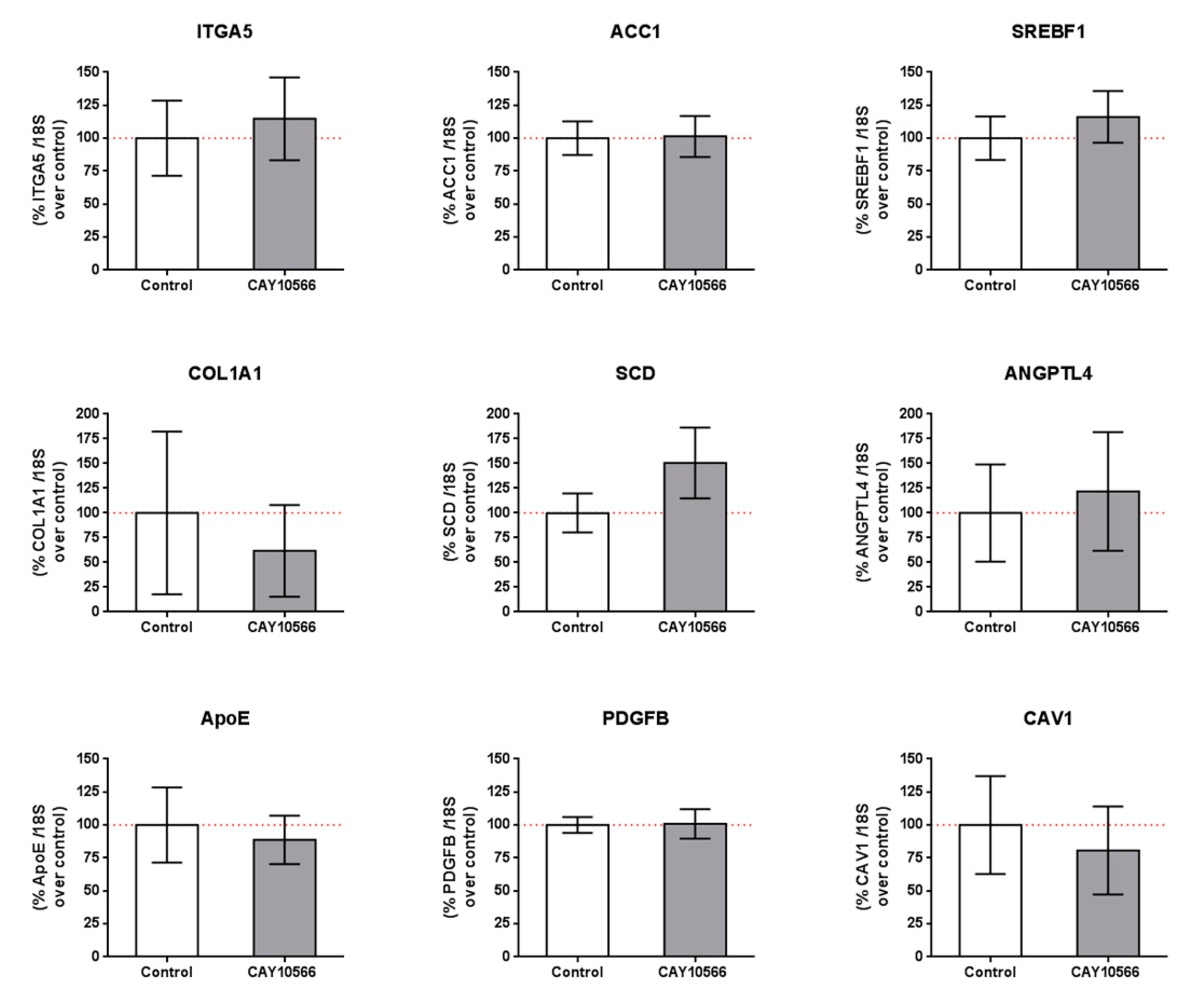Genome-Wide Transcriptomic Analysis Identifies Pathways Regulated by Sterculic Acid in Retinal Pigmented Epithelium Cells
Abstract
1. Introduction
2. Material and Methods
2.1. Cell Lines and Culture
2.2. Cell Treatments
2.3. Cell Viability Assays
2.4. RNA Purification
2.5. Quantitative Real-Time PCR
2.6. Next Generation Sequencing
2.7. Inmunofluorescence and Confocal Microscopy
2.8. ELISA
2.9. Statistical Analysis
3. Results
3.1. Sterculic Acid Does Not Present Cell Toxicity to Retinal Cell In Vitro
3.2. Sterculic Acid Administration is Protective Against 7KCh-Induced Cell Death In Vitro
4. Discussion
Supplementary Materials
Author Contributions
Funding
Conflicts of Interest
Abbreviations
| 7KCh | 7-ketocholesterol |
| AMD | Age-related macular degeneration |
| CVN | Choroidal neovascularization |
| DEG | Differentially expressed genes |
| DMEM | Dulbecco’s Modified Eagle medium |
| ECM | Extracellular matrix |
| ER | Endoplasmic reticulum |
| FDR | False discovery rate |
| GO | Gene ontology |
| HPBCD | Hydroxypropyl-beta-cyclodextrin |
| KEGG | Kyoto Encyclopedia of Genes and Genomes |
| mRPE | Monkey retinal pigment epithelium cells |
| MUFA | Monounsaturated fatty acid |
| RPE: | Retinal pigment epithelium |
| SA | Sterculic acid |
| SO | Sterculic oil |
References
- Mattson, M.P. Hormesis defined. Ageing Res. Rev. 2008, 7, 1–7. [Google Scholar] [CrossRef] [PubMed]
- Galluzzi, L.; Vitale, I.; Aaronson, S.A.; Abrams, J.M.; Adam, D.; Agostinis, P.; Alnemri, E.S.; Altucci, L.; Amelio, I.; Andrews, D.W.; et al. Molecular mechanisms of cell death: Recommendations of the Nomenclature Committee on Cell Death 2018. Cell Death Differ. 2018, 25, 486–541. [Google Scholar] [CrossRef] [PubMed]
- Ashkenazi, A.; Salvesen, G. Regulated cell death: Signaling and mechanisms. Annu. Rev. Cell Dev. Biol. 2014, 30, 337–356. [Google Scholar] [CrossRef] [PubMed]
- Bird, A.C. Therapeutic targets in age-related macular disease. J. Clin. Investig. 2010, 120, 3033–3041. [Google Scholar] [CrossRef] [PubMed]
- Chistyakov, D.V.; Baksheeva, V.E.; Tiulina, V.V.; Goriainov, S.V.; Azbukina, N.V.; Gancharova, O.S.; Arifulin, E.A.; Komarov, S.V.; Chistyakov, V.V.; Tikhomirova, N.K.; et al. Mechanisms and Treatment of Light-Induced Retinal Degeneration-Associated Inflammation: Insights from Biochemical Profiling of the Aqueous Humor. Int. J. Mol. Sci. 2020, 21, 704. [Google Scholar] [CrossRef] [PubMed]
- Grossniklaus, H.E.; Geisert, E.E.; Nickerson, J.M. Introduction to the Retina. Prog. Mol. Biol. Transl. Sci. 2015, 134, 383–396. [Google Scholar]
- Bhutto, I.; Lutty, G. Understanding age-related macular degeneration (AMD): Relationships between the photoreceptor/retinal pigment epithelium/Bruch’s membrane/choriocapillaris complex. Mol. Aspects Med. 2012, 33, 295–317. [Google Scholar] [CrossRef]
- Strauss, O. The retinal pigment epithelium in visual function. Physiol. Rev. 2005, 85, 845–881. [Google Scholar] [CrossRef]
- Ambati, J.; Fowler, B.J. Mechanisms of age-related macular degeneration. Neuron 2012, 75, 26–39. [Google Scholar] [CrossRef]
- Thompson, R.B.; Reffatto, V.; Bundy, J.G.; Kortvely, E.; Flinn, J.M.; Lanzirotti, A.; Jones, E.A.; McPhail, D.S.; Fearn, S.; Boldt, K.; et al. Identification of hydroxyapatite spherules provides new insight into subretinal pigment epithelial deposit formation in the aging eye. Proc. Natl. Acad. Sci. USA 2015, 112, 1565–1570. [Google Scholar] [CrossRef]
- Moreira, E.F.; Larrayoz, I.M.; Lee, J.W.; Rodriguez, I.R. 7-Ketocholesterol is present in lipid deposits in the primate retina: Potential implication in the induction of VEGF and CNV formation. Investig. Ophthalmol. Vis. Sci. 2009, 50, 523–532. [Google Scholar] [CrossRef] [PubMed]
- Huang, J.D.; Amaral, J.; Lee, J.W.; Larrayoz, I.M.; Rodriguez, I.R. Sterculic acid antagonizes 7-ketocholesterol-mediated inflammation and inhibits choroidal neovascularization. Biochim. Biophys. Acta 2012, 1821, 637–646. [Google Scholar] [CrossRef] [PubMed][Green Version]
- Huang, J.D.; Amaral, J.; Lee, J.W.; Rodriguez, I.R. 7-Ketocholesterol-induced inflammation signals mostly through the TLR4 receptor both in vitro and in vivo. PLoS ONE 2014, 9, e100985. [Google Scholar] [CrossRef]
- Rodriguez, I.R.; Larrayoz, I.M. Cholesterol oxidation in the retina: Implications of 7KCh formation in chronic inflammation and age-related macular degeneration. J. Lipid Res. 2010, 51, 2847–2862. [Google Scholar] [CrossRef]
- Buttari, B.; Segoni, L.; Profumo, E.; D’Arcangelo, D.; Rossi, S.; Facchiano, F.; Businaro, R.; Iuliano, L.; Rigano, R. 7-Oxo-cholesterol potentiates pro-inflammatory signaling in human M1 and M2 macrophages. Biochem. Pharmacol. 2013, 86, 130–137. [Google Scholar] [CrossRef] [PubMed]
- Hayden, J.M.; Brachova, L.; Higgins, K.; Obermiller, L.; Sevanian, A.; Khandrika, S.; Reaven, P.D. Induction of monocyte differentiation and foam cell formation in vitro by 7-ketocholesterol. J. Lipid Res. 2002, 43, 26–35. [Google Scholar]
- Pedruzzi, E.; Guichard, C.; Ollivier, V.; Driss, F.; Fay, M.; Prunet, C.; Marie, J.C.; Pouzet, C.; Samadi, M.; Elbim, C.; et al. NAD(P)H oxidase Nox-4 mediates 7-ketocholesterol-induced endoplasmic reticulum stress and apoptosis in human aortic smooth muscle cells. Mol. Cell Biol. 2004, 24, 10703–10717. [Google Scholar] [CrossRef]
- Vejux, A.; Lizard, G. Cytotoxic effects of oxysterols associated with human diseases: Induction of cell death (apoptosis and/or oncosis), oxidative and inflammatory activities, and phospholipidosis. Mol. Aspects Med. 2009, 30, 153–170. [Google Scholar]
- Cheng, D.; Jenner, A.M.; Shui, G.; Cheong, W.F.; Mitchell, T.W.; Nealon, J.R.; Kim, W.S.; McCann, H.; Wenk, M.R.; Halliday, G.M.; et al. Lipid pathway alterations in Parkinson’s disease primary visual cortex. PLoS ONE 2011, 6, e17299. [Google Scholar] [CrossRef]
- Nakaya, K.; Ayaori, M.; Uto-Kondo, H.; Sotherden, G.M.; Nishida, T.; Katamoto, H.; Miura, Y.; Takiguchi, S.; Yakushiji, E.; Iizuka, M.; et al. Overexpression of stearoyl-coenzyme A desaturase 1 in macrophages promotes reverse cholesterol transport. Biochim. Biophys. Acta 2013, 1831, 1402–1411. [Google Scholar]
- Olivier, E.; Dutot, M.; Regazzetti, A.; Leguillier, T.; Dargere, D.; Auzeil, N.; Laprevote, O.; Rat, P. P2X7-pannexin-1 and amyloid beta-induced oxysterol input in human retinal cell: Role in age-related macular degeneration? Biochimie 2016, 127, 70–78. [Google Scholar] [CrossRef] [PubMed]
- Phan, H.T.; Hata, T.; Morita, M.; Yoda, T.; Hamada, T.; Vestergaard, M.C.; Takagi, M. The effect of oxysterols on the interaction of Alzheimer’s amyloid beta with model membranes. Biochim. Biophys. Acta 2013, 1828, 2487–2495. [Google Scholar] [CrossRef] [PubMed]
- Testa, G.; Staurenghi, E.; Zerbinati, C.; Gargiulo, S.; Iuliano, L.; Giaccone, G.; Fanto, F.; Poli, G.; Leonarduzzi, G.; Gamba, P. Changes in brain oxysterols at different stages of Alzheimer’s disease: Their involvement in neuroinflammation. Redox Biol. 2016, 10, 24–33. [Google Scholar] [CrossRef] [PubMed]
- Larrayoz, I.M.; Huang, J.D.; Lee, J.W.; Pascual, I.; Rodriguez, I.R. 7-ketocholesterol-induced inflammation: Involvement of multiple kinase signaling pathways via NFkappaB but independently of reactive oxygen species formation. Investig. Ophthalmol Vis. Sci. 2010, 51, 4942–4955. [Google Scholar] [CrossRef]
- Pariente, A.; Pelaez, R.; Perez-Sala, A.; Larrayoz, I.M. Inflammatory and cell death mechanisms induced by 7-ketocholesterol in the retina. Implications for age-related macular degeneration. Exp. Eye Res. 2019, 187, 107746. [Google Scholar] [CrossRef]
- Dugas, B.; Charbonnier, S.; Baarine, M.; Ragot, K.; Delmas, D.; Menetrier, F.; Lherminier, J.; Malvitte, L.; Khalfaoui, T.; Bron, A.; et al. Effects of oxysterols on cell viability, inflammatory cytokines, VEGF, and reactive oxygen species production on human retinal cells: Cytoprotective effects and prevention of VEGF secretion by resveratrol. Eur. J. Nutr. 2010, 49, 435–446. [Google Scholar] [CrossRef]
- Ortinau, L.C.; Nickelson, K.J.; Stromsdorfer, K.L.; Naik, C.Y.; Pickering, R.T.; Haynes, R.A.; Fritsche, K.L.; Perfield, J.W., 2nd. Sterculic oil, a natural inhibitor of SCD1, improves the metabolic state of obese OLETF rats. Obesity (Silver Spring) 2013, 21, 344–352. [Google Scholar] [CrossRef]
- Bichi, E.; Toral, P.G.; Hervas, G.; Frutos, P.; Gomez-Cortes, P.; Juarez, M.; de la Fuente, M.A. Inhibition of 9-desaturase activity with sterculic acid: Effect on the endogenous synthesis of cis-9 18:1 and cis-9, trans-11 18:2 in dairy sheep. J. Dairy Sci. 2012, 95, 5242–5252. [Google Scholar] [CrossRef]
- Raju, P.K.; Reiser, R. Inhibition of fatty acyl desaturase by cyclopropene fatty acids. J. Biol. Chem. 1967, 242, 379–384. [Google Scholar]
- Jeffcoat, R.; Pollard, M.R. Studies on the inhibition of the desaturases by cyclopropenoid fatty acids. Lipids 1977, 12, 480–485. [Google Scholar] [CrossRef]
- Galbraith, L.; Leung, H.Y.; Ahmad, I. Lipid pathway deregulation in advanced prostate cancer. Pharmacol. Res. 2018, 131, 177–184. [Google Scholar] [CrossRef] [PubMed]
- Uto, Y. Recent progress in the discovery and development of stearoyl CoA desaturase inhibitors. Chem. Phys. Lipids 2016, 197, 3–12. [Google Scholar] [CrossRef] [PubMed]
- Dalla Valle, A.; Vertongen, P.; Spruyt, D.; Lechanteur, J.; Suain, V.; Gaspard, N.; Brion, J.P.; Gangji, V.; Rasschaert, J. Induction of Stearoyl-CoA 9-Desaturase 1 Protects Human Mesenchymal Stromal Cells Against Palmitic Acid-Induced Lipotoxicity and Inflammation. Front. Endocrinol. (Lausanne) 2019, 10, 726. [Google Scholar] [PubMed]
- Kadegowda, A.K.; Burns, T.A.; Pratt, S.L.; Duckett, S.K. Inhibition of stearoyl-CoA desaturase 1 reduces lipogenesis in primary bovine adipocytes. Lipids 2013, 48, 967–976. [Google Scholar] [CrossRef] [PubMed]
- Gomez, F.E.; Bauman, D.E.; Ntambi, J.M.; Fox, B.G. Effects of sterculic acid on stearoyl-CoA desaturase in differentiating 3T3-L1 adipocytes. Biochem. Biophys. Res. Commun. 2003, 300, 316–326. [Google Scholar] [CrossRef]
- Herrera-Meza, M.S.; Mendoza-Lopez, M.R.; Garcia-Barradas, O.; Sanchez-Otero, M.G.; Silva-Hernandez, E.R.; Angulo, J.O.; Oliart-Ros, R.M. Dietary anhydrous milk fat naturally enriched with conjugated linoleic acid and vaccenic acid modify cardiovascular risk biomarkers in spontaneously hypertensive rats. Int. J. Food Sci. Nutr. 2013, 64, 575–586. [Google Scholar] [CrossRef]
- Ortinau, L.C.; Pickering, R.T.; Nickelson, K.J.; Stromsdorfer, K.L.; Naik, C.Y.; Haynes, R.A.; Bauman, D.E.; Rector, R.S.; Fritsche, K.L.; Perfield, J.W., 2nd. Sterculic Oil, a Natural SCD1 Inhibitor, Improves Glucose Tolerance in Obese ob/ob Mice. ISRN Endocrinol. 2012, 2012, 947323. [Google Scholar] [CrossRef]
- Pikuleva, I.A.; Curcio, C.A. Cholesterol in the retina: The best is yet to come. Prog. Retin. Eye Res. 2014, 41, 64–89. [Google Scholar] [CrossRef]
- Fliesler, S.J.; Ferrington, D.A. EDITORIAL: Special issue on the role of lipid and protein oxidation in retinal degenerations. Exp. Eye Res. 2019, 181, 313–315. [Google Scholar] [CrossRef]
- Fliesler, S.J.; Xu, L. Oxysterols and Retinal Degeneration in a Rat Model of Smith-Lemli-Opitz Syndrome: Implications for an Improved Therapeutic Intervention. Molecules 2018, 23, 2720. [Google Scholar] [CrossRef]
- Major, C.A.; Ryan, K.; Bennett, A.J.; Lock, A.L.; Bauman, D.E.; Salter, A.M. Inhibition of stearoyl CoA desaturase activity induces hypercholesterolemia in the cholesterol-fed hamster. J. Lipid Res. 2008, 49, 1456–1465. [Google Scholar] [CrossRef] [PubMed]
- Pelaez, R.; Pariente, A.; Perez-Sala, A.; Larrayoz, I.M. Sterculic Acid: The Mechanisms of Action beyond Stearoyl-CoA Desaturase Inhibition and Therapeutic Opportunities in Human Diseases. Cells 2020, 9, 140. [Google Scholar] [CrossRef] [PubMed]
- Bogie, J.F.J.; Grajchen, E.; Wouters, E.; Corrales, A.G.; Dierckx, T.; Vanherle, S.; Mailleux, J.; Gervois, P.; Wolfs, E.; Dehairs, J.; et al. Stearoyl-CoA desaturase-1 impairs the reparative properties of macrophages and microglia in the brain. J. Exp. Med. 2020, 217, e20191660. [Google Scholar] [CrossRef] [PubMed]
- Dunn, K.C.; Aotaki-Keen, A.E.; Putkey, F.R.; Hjelmeland, L.M. ARPE-19, a human retinal pigment epithelial cell line with differentiated properties. Exp. Eye Res. 1996, 62, 155–169. [Google Scholar] [CrossRef]
- Becerra, S.P.; Fariss, R.N.; Wu, Y.Q.; Montuenga, L.M.; Wong, P.; Pfeffer, B.A. Pigment epithelium-derived factor in the monkey retinal pigment epithelium and interphotoreceptor matrix: Apical secretion and distribution. Exp. Eye Res. 2004, 78, 223–234. [Google Scholar] [CrossRef]
- Pfeffer, B.A.; Xu, L.; Porter, N.A.; Rao, S.R.; Fliesler, S.J. Differential cytotoxic effects of 7-dehydrocholesterol-derived oxysterols on cultured retina-derived cells: Dependence on sterol structure, cell type, and density. Exp. Eye Res. 2016, 145, 297–316. [Google Scholar] [CrossRef]
- Songstad, A.E.; Worthington, K.S.; Chirco, K.R.; Giacalone, J.C.; Whitmore, S.S.; Anfinson, K.R.; Ochoa, D.; Cranston, C.M.; Riker, M.J.; Neiman, M.; et al. Connective Tissue Growth Factor Promotes Efficient Generation of Human Induced Pluripotent Stem Cell-Derived Choroidal Endothelium. Stem Cells Transl. Med. 2017, 6, 1533–1546. [Google Scholar] [CrossRef]
- Larrayoz, I.M.; Rua, O.; Velilla, S.; Martinez, A. Transcriptomic profiling explains racial disparities in pterygium patients treated with doxycycline. Investig. Ophthalmol. Vis. Sci. 2014, 55, 7553–7561. [Google Scholar] [CrossRef] [PubMed]
- Kanehisa, M.; Goto, S. KEGG: Kyoto encyclopedia of genes and genomes. Nucleic Acids Res. 2000, 28, 27–30. [Google Scholar] [CrossRef]
- Kanehisa, M.; Goto, S.; Sato, Y.; Kawashima, M.; Furumichi, M.; Tanabe, M. Data, information, knowledge and principle: Back to metabolism in KEGG. Nucleic Acids Res. 2014, 42, D199–D205. [Google Scholar] [CrossRef]
- Ralston, J.C.; Badoud, F.; Cattrysse, B.; McNicholas, P.D.; Mutch, D.M. Inhibition of stearoyl-CoA desaturase-1 in differentiating 3T3-L1 preadipocytes upregulates elongase 6 and downregulates genes affecting triacylglycerol synthesis. Int. J. Obes. (Lond.) 2014, 38, 1449–1456. [Google Scholar] [CrossRef] [PubMed]
- Hao, P.; Alaraj, I.Q.; Dulayymi, J.R.; Baird, M.S.; Liu, J.; Liu, Q. Sterculic Acid and Its Analogues Are Potent Inhibitors of Toxoplasma gondii. Korean J. Parasitol. 2016, 54, 139–145. [Google Scholar] [CrossRef] [PubMed]
- Astarita, G.; Jung, K.M.; Vasilevko, V.; Dipatrizio, N.V.; Martin, S.K.; Cribbs, D.H.; Head, E.; Cotman, C.W.; Piomelli, D. Elevated stearoyl-CoA desaturase in brains of patients with Alzheimer’s disease. PLoS ONE 2011, 6, e24777. [Google Scholar] [CrossRef] [PubMed]
- Fritz, V.; Benfodda, Z.; Rodier, G.; Henriquet, C.; Iborra, F.; Avances, C.; Allory, Y.; de la Taille, A.; Culine, S.; Blancou, H.; et al. Abrogation of de novo lipogenesis by stearoyl-CoA desaturase 1 inhibition interferes with oncogenic signaling and blocks prostate cancer progression in mice. Mol. Cancer Ther. 2010, 9, 1740–1754. [Google Scholar] [CrossRef]
- Hess, D.; Chisholm, J.W.; Igal, R.A. Inhibition of stearoylCoA desaturase activity blocks cell cycle progression and induces programmed cell death in lung cancer cells. PLoS ONE 2010, 5, e11394. [Google Scholar] [CrossRef]
- Scaglia, N.; Igal, R.A. Inhibition of Stearoyl-CoA Desaturase 1 expression in human lung adenocarcinoma cells impairs tumorigenesis. Int. J. Oncol. 2008, 33, 839–850. [Google Scholar]
- Wang, T.; Lee, H.; Zhen, Y. Responses of MAC-T Cells to Inhibited Stearoyl-CoA Desaturase 1 during cis-9, trans-11 Conjugated Linoleic Acid Synthesis. Lipids 2018, 53, 647–652. [Google Scholar] [CrossRef]
- Lee, D.K.; Choi, K.H.; Hwang, J.Y.; Oh, J.N.; Kim, S.H.; Lee, C.K. Stearoyl-coenzyme A desaturase 1 is required for lipid droplet formation in pig embryo. Reproduction 2019, 157, 235–243. [Google Scholar] [CrossRef]
- Seibert, J.T.; Abuajamieh, M.; Sanz Fernandez, M.V.; Johnson, J.S.; Kvidera, S.K.; Horst, E.A.; Mayorga, E.J.; Lei, S.; Patience, J.F.; Ross, J.W.; et al. Effects of heat stress and insulin sensitizers on pig adipose tissue. J. Anim. Sci. 2018, 96, 510–520. [Google Scholar] [CrossRef]
- Herrera-Meza, S.; Rodriguez-Landa, J.F.; Martinez, A.J.; Herrera-Meza, G.; Fernandez-Demeneghi, R.; Reyes-Saldana, K.; Oliart-Ros, R.M. Behavioral Effect of Sterculia apetala Seed Oil Consumption in Male Zucker Rats. J. Med. Food 2017, 20, 1133–1139. [Google Scholar] [CrossRef]
- Allen, E.; Johnson, A.R.; Fogerty, A.C.; Pearson, J.A.; Shenstone, F.S. Inhibition by cyclopropene fatty acids of the desaturation of stearic acid in hen liver. Lipids 1967, 2, 419–423. [Google Scholar] [CrossRef] [PubMed]
- Lee, D.J.; Wales, J.H.; Sinnhuber, R.O. Promotion of aflatoxin-induced hepatoma growth in trout by methyl malvalate and sterculate. Cancer Res. 1971, 31, 960–963. [Google Scholar] [PubMed]
- Lock, A.L.; Corl, B.A.; Barbano, D.M.; Bauman, D.E.; Ip, C. The anticarcinogenic effect of trans-11 18:1 is dependent on its conversion to cis-9, trans-11 CLA by delta9-desaturase in rats. J. Nutr. 2004, 134, 2698–2704. [Google Scholar] [CrossRef] [PubMed]





| Gene Name | Oligonucleotide Sequence |
|---|---|
| SCD-F | 5′-ATAAGTTGGAGACGACGCCC-3′ |
| SCD-R | 5′-GGCTCCCAAGTGTAGCAGAG-3′ |
| SREBF1-F | 5′-CGTTTCTTCGTGGATGGGGA-3′ |
| SREBF1-R | 5′-TTCAGTGCTCGCTCCAAGAG-3′ |
| ITGA5-F | 5′-TCTTGCTGGACTGTGGAGAG-3′ |
| ITGA5-R | 5′-AGGGCATTCTTGTCACCCAG-3′ |
| APOE-F | 5′-CTGCGTTGCTGGTCACATTC-3′ |
| APOE-R | 5′-CGCAGGTAATCCCAAAAGCG-3′ |
| ANGPTL4-F | 5′-CAAGGCTCAGAACAGCAGGA-3′ |
| ANGPTL4-R | 5′-CTCTTTCTTCGGGCAGGCTT-3′ |
| CAV1-F | 5′-GCAGAACCAGAAGGGACACA-3′ |
| CAV1-R | 5′-GATGCCAAAGAGGGCAGACA-3′ |
| PDGFB-F | 5′-CCACTCCATCCGCTCCTTC-3′ |
| PDGFB-R | 5′-CTCCTTCTTCCACGAGCCAG-3′ |
| COL1A1-F | 5′-GCCAAGACGAAGACATCCCA-3′ |
| COL1A1-R | 5′-GGCAGTTCTTGGTCTCGTCA-3′ |
| ACC1-F | 5′-ATTGCCTTCATGGGTCCTCC-3′ |
| ACC1-R | 5′-CTCCAGGGAAGAGTTGGGAT-3′ |
| 18S-F | 5′-ATGCTCTTAGCTGAGTGTCCCG-3′ |
| 18S-R | 5′-ATTCCTAGCTGCGGTATCCAGG-3′ |
| Pathway | Gene | Log2 Fold Change | FDR | Gene Description |
|---|---|---|---|---|
| Fatty acid biosynthesis | ||||
| CREB3L1 | −0.68 | 1.29 × 10−2 | cAMP responsive element binding protein 3 like 1 | |
| SREBF1 | −0.79 | 1.83 × 10−2 | sterol regulatory element binding transcription factor 1 | |
| FASN | −0.62 | 2.18 × 10−2 | fatty acid synthase | |
| ACC1 | −0.47 | 6.86 × 10−6 | Acetyl-CoA Carboxylase Alpha | |
| SCD | −1.18 | 3.18 × 10−5 | Stearoyl-CoA Desaturase | |
| Steroid Biosynthesis | ||||
| HMGCS1 | −0.87 | 1.13 × 10−2 | 3-Hydroxy-3-Methylglutaryl-CoA Synthase | |
| MVD | −0.66 | 3.06 × 10−2 | mevalonate diphosphate decarboxylase | |
| FDFT1 | −0.31 | 1.14 × 10−3 | Farnesyl-Diphosphate Farnesyltransferase 1 | |
| SQLE | −0.50 | 1.41 × 10−5 | squalene epoxidase | |
| LSS | −0.77 | 3.89 × 10−6 | lanosterol synthase | |
| CYP51A1 | −0.47 | 2.18 × 10−2 | Cytochrome P450 Family 51 Subfamily A Member 1 | |
| MSMO1 | −0.61 | 1.35 × 10−2 | Methylsterol Monooxygenase 1 | |
| HSD17B7 | −0.28 | 3.60 × 10−2 | 3-keto-steroid reductase | |
| NSDHL | −0.53 | 3.74 × 10−3 | NAD(P) Dependent Steroid Dehydrogenase-Like | |
| EBP | −0.75 | 4.75 × 10−7 | EBP Cholestenol Delta-Isomerase | |
| Fatty acid degradation and beta-oxidation | ||||
| CPT1A | 0.97 | 1.07 × 10−12 | Carnitine Palmitoyltransferase 1A | |
| SLC25A20 | 0.82 | 4.61 × 10−6 | solute carrier family 25 member 20 | |
| ACADS | 0.50 | 5.76 × 10−3 | acyl-CoA dehydrogenase short chain | |
| ACADVL | 0.58 | 1.63 × 10−5 | acyl-CoA dehydrogenase very long chain | |
| Cell Death | ||||
| CASP8 | −0.36 | 3.20 × 10−2 | caspase 8 | |
| CASP1 | −0.86 | 3.38 × 10−2 | caspase-1 | |
| GSDMD | −0.59 | 2.21 × 10−3 | gasdermin D | |
| TNFRSF10A | −0.52 | 6.56 × 10−4 | TNF receptor superfamily member 10a | |
| ECM-Receptor interaction, cell adhesion, Cell junction | ||||
| COL1A1 | −1.37 | 9.76 × 10−5 | collagen type I alpha 1 chain | |
| COL1A2 | −0.96 | 2.61 × 10−7 | collagen type I alpha 2 chain | |
| COL3A1 | −1.66 | 2.74 × 10−21 | collagen type III alpha 1 chain | |
| COL5A2 | −0.73 | 3.23 × 10−20 | collagen type V alpha 2 chain | |
| COL7A1 | −1.04 | 2.25 × 10−5 | Collagen Type VII Alpha 1 Chain | |
| COL8A1 | −0.62 | 3.38 × 10−5 | collagen type VIII alpha 1 chain | |
| COL9A1 | −2.11 | 1.27 × 10−4 | Collagen Type IX Alpha 1 Chain | |
| COl11A1 | −0.63 | 1.45 × 10−4 | collagen type XI alpha 1 chain | |
| COL16A1 | −1.82 | 2.78 × 10−10 | collagen type XVI alpha 1 chain | |
| COL17A1 | −2.91 | 9.06 × 10−4 | collagen type XVII alpha 1 chain | |
| LAMA3 | −0.98 | 8.32 × 10−7 | laminin subunit alpha 3 | |
| LAMC1 | −0.32 | 2.90 × 10−2 | laminin subunit gamma 1 | |
| THBS3 | −0.50 | 1.73 × 10−2 | thrombospondin 3 | |
| FN1 | −0.86 | 4.27 × 10−4 | fibronectin 1 | |
| CHST2 | 1.14 | 3.64 × 10−5 | carbohydrate sulfotransferase 2 | |
| CHST12 | 0.68 | 4.09 × 10−2 | carbohydrate sulfotransferase 12 | |
| CHST15 | 0.56 | 6.66 × 10−4 | carbohydrate sulfotransferase 15 | |
| CD274 | −0.82 | 1.39 × 10−2 | CD274 Molecule | |
| ITGA5 | −0.64 | 1.29 × 10−2 | integrin subunit alpha 5 | |
| ITGB2 | −0.36 | 1.41 × 10−2 | integrin subunit beta 2 | |
| CLDN16 | −1.46 | 3.74 × 10−2 | claudin 16 | |
| IGFBP3 | −0.93 | 2.69 × 10−6 | insulin like growth factor binding protein 3 | |
| IGFBP4 | −0.59 | 1.50 × 10−2 | insulin like growth factor binding protein 4 | |
| IGFBP5 | −2.31 | 1.62 × 10−50 | insulin like growth factor binding protein 5 | |
| IGFBP8 | 1.01 | 4.49 × 10−5 | insulin like growth factor binding protein 8 | |
| IGFBP9 | −1.74 | 8.74 × 10−08 | insulin like growth factor binding protein 9 | |
| SDC2 | −0.44 | 7.97 × 10−3 | syndecan 2 | |
| CDH1 | −1.38 | 4.37 × 10−4 | cadherin 1 | |
| CDH3 | −2.29 | 3.50 × 10−15 | cadherin 3 | |
| CDH10 | −1.50 | 1.60 × 10−2 | cadherin 10 | |
| CDH15 | −1.22 | 4.74 × 10−2 | cadherin 15 | |
| VCAN | −1.18 | 1.14 × 10−2 | versican | |
| NCAM1 | −0.27 | 3.20 × 10−3 | neural cell adhesion molecule 1 | |
| Actin cytoskeleton reorganization | ||||
| FLNB | −0.48 | 4.16 × 10−2 | filamin B | |
| PARVA | −0.33 | 2.97 × 10−4 | parvin alpha | |
| MYLPF | −1.31 | 1.05 × 10−3 | myosin light chain, phosphorylatable, fast skeletal muscle | |
| MLCP | −0.59 | 2.39 × 10−2 | Protein Phosphatase 1 Regulatory Subunit 12A | |
| RHOJ | −1.21 | 1.32 × 10−2 | ras homolog family member J |
© 2020 by the authors. Licensee MDPI, Basel, Switzerland. This article is an open access article distributed under the terms and conditions of the Creative Commons Attribution (CC BY) license (http://creativecommons.org/licenses/by/4.0/).
Share and Cite
Pariente, A.; Pérez-Sala, Á.; Ochoa, R.; Peláez, R.; Larráyoz, I.M. Genome-Wide Transcriptomic Analysis Identifies Pathways Regulated by Sterculic Acid in Retinal Pigmented Epithelium Cells. Cells 2020, 9, 1187. https://doi.org/10.3390/cells9051187
Pariente A, Pérez-Sala Á, Ochoa R, Peláez R, Larráyoz IM. Genome-Wide Transcriptomic Analysis Identifies Pathways Regulated by Sterculic Acid in Retinal Pigmented Epithelium Cells. Cells. 2020; 9(5):1187. https://doi.org/10.3390/cells9051187
Chicago/Turabian StylePariente, Ana, Álvaro Pérez-Sala, Rodrigo Ochoa, Rafael Peláez, and Ignacio M. Larráyoz. 2020. "Genome-Wide Transcriptomic Analysis Identifies Pathways Regulated by Sterculic Acid in Retinal Pigmented Epithelium Cells" Cells 9, no. 5: 1187. https://doi.org/10.3390/cells9051187
APA StylePariente, A., Pérez-Sala, Á., Ochoa, R., Peláez, R., & Larráyoz, I. M. (2020). Genome-Wide Transcriptomic Analysis Identifies Pathways Regulated by Sterculic Acid in Retinal Pigmented Epithelium Cells. Cells, 9(5), 1187. https://doi.org/10.3390/cells9051187





